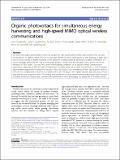Organic photovoltaics for simultaneous energy harvesting and high-speed MIMO optical wireless communications
Abstract
We show that organic photovoltaics (OPVs) are suitable for high-speed optical wireless data receivers that can also harvest power. In addition, these OPVs are of particular interest for indoor applications, as their bandgap is larger than that of silicon, leading to better matching to the spectrum of artificial light. By selecting a suitable combination of a narrow bandgap donor polymer and a nonfullerene acceptor, stable OPVs are fabricated with a power conversion efficiency of 8.8% under 1 Sun and 14% under indoor lighting conditions. In an optical wireless communication experiment, a data rate of 363 Mb/s and a simultaneous harvested power of 10.9 mW are achieved in a 4-by-4 multiple-input multiple-output (MIMO) setup that consists of four laser diodes, each transmitting 56 mW optical power and four OPV cells on a single panel as receivers at a distance of 40 cm. This result is the highest reported data rate using OPVs as data receivers and energy harvesters. This finding may be relevant to future mobile communication applications because it enables enhanced wireless data communication performance while prolonging the battery life in a mobile device.
Citation
Tavakkolnia , I , Krishnan Jagadamma , L , Bian , R , Manousiadis , P , Videv , S , Turnbull , G , Samuel , I D W & Haas , H 2021 , ' Organic photovoltaics for simultaneous energy harvesting and high-speed MIMO optical wireless communications ' , Light: Science & Applications , vol. 10 , 41 . https://doi.org/10.1038/s41377-021-00487-9
Publication
Light: Science & Applications
Status
Peer reviewed
ISSN
2047-7538Type
Journal article
Description
H.H. acknowledges the financial support from the Wolfson Foundation and Royal Society. He also acknowledges financial support from the Engineering and Physical Sciences Research Council (EPSRC) under the Established Career Fellowship grant EP/R007101/1. The authors acknowledge the EPSRC for financial support from the program/project grants EP/K00042X/1 and EP/R005281/1. L.K.J. acknowledges support from a Marie Skłodowska-Curie Individual Fellowship (European Commission) (MCIF: no. 745776)Collections
Items in the St Andrews Research Repository are protected by copyright, with all rights reserved, unless otherwise indicated.

